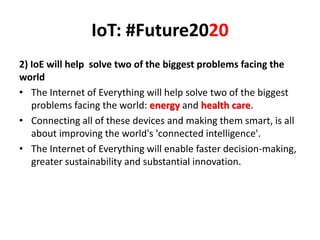Iot
- 1. IOT: Internet Of Things The Next Big Thing By: Shivam Prakash Chaurasia
- 2. Introduction • The Internet of Things (IoT) is a computing concept that describes a future where everyday physical objects will be connected to the Internet and be able to identify themselves to other devices. • It is an environment in which objects, animals or people are provided with unique identifiers and the ability to transfer data over a network without requiring human-to-human or human-to-computer interaction.
- 3. IoT: Future • Gartner estimates that by 2020, there will be some 30 billion connected devices. • IDC is even more bullish and expects there to be about 200 billion connected devices by 2021. • It is a $19 trillion global opportunity over the next decade. • Private-sector firms can create as much as $14.4 trillion of value while cities, governments and other public-sector organizations can create $4.6 trillion. • Technology is evolving rapidly. It has, and will continue to, profoundly change our lives in the years to come
- 4. So, What kind of positive changes can we expect to see rising out of the Internet of Everything (IoE) by 2020?
- 5. IoT: #Future2020 1) By 2020 we could expect to see a massive Internet of Everything in linear knowledge taking place through any device, anywhere. • This process perfectly captures how a connection between the four pillars of IoE - people, process, data and things - is already influencing. • Through IoE, the linear knowledge-sharing dialogue between teacher and student can evolve into something entirely within the student's control. • They will be able to learn at their own pace, focusing more on what they perceive as relevant to them.
- 6. IoT: #Future2020 2) IoE will help solve two of the biggest problems facing the world • The Internet of Everything will help solve two of the biggest problems facing the world: energy and health care. • Connecting all of these devices and making them smart, is all about improving the world's 'connected intelligence'. • The Internet of Everything will enable faster decision-making, greater sustainability and substantial innovation.
- 7. IoT: #Future2020 • Manufacturing and IT will become inherently connected by 2022 and, as such, both sectors will gain a far deeper understanding of the other. • 3) Smarter Manufacturing will be the word of the day • The industry is entering a new digitalized environment with the help of IoE. • It certainly stands to reason manufacturing plants themselves will need to be as 'intelligent' as the billions of connected devices they produce, if not more so.
- 8. IoT: #Future2020 • 4) New opportunities to create new products and services as products become connected • Businesses will see new opportunities to create new products and services based around growing IoE connections. • As products become connected - as milk cartons go digital and toothbrushes become intelligent - the amount of data produced will be vast. • In connecting the unconnected, a process which is currently churning out 25,000 connecting devices every 15 minutes, it is estimated that 220,000 new engineers will be needed each year between now and 2022.









